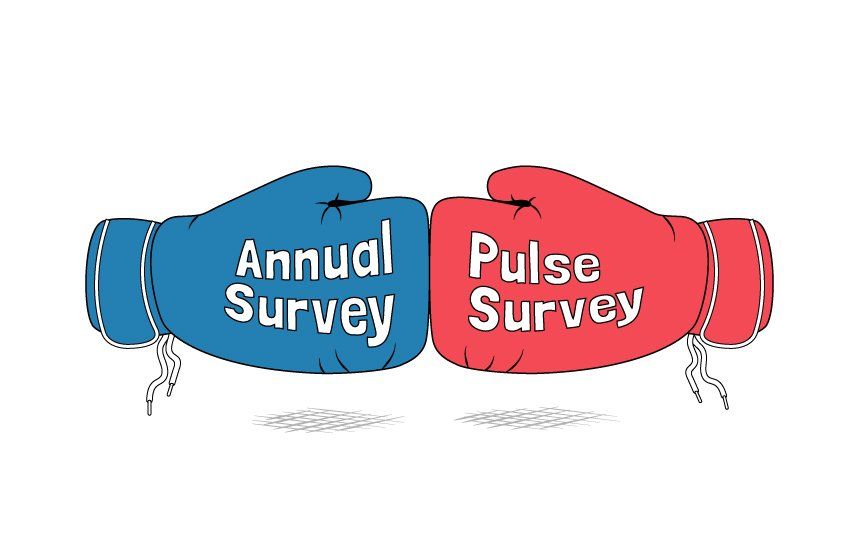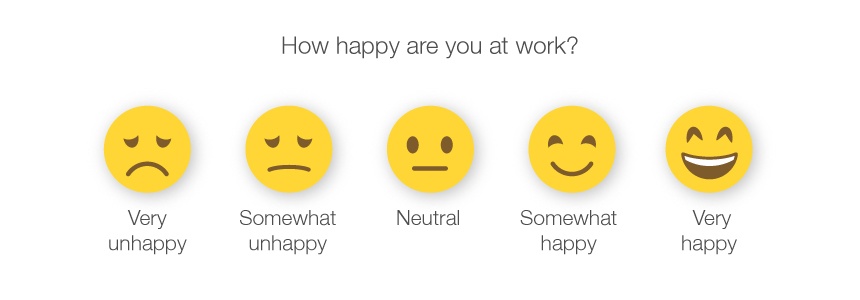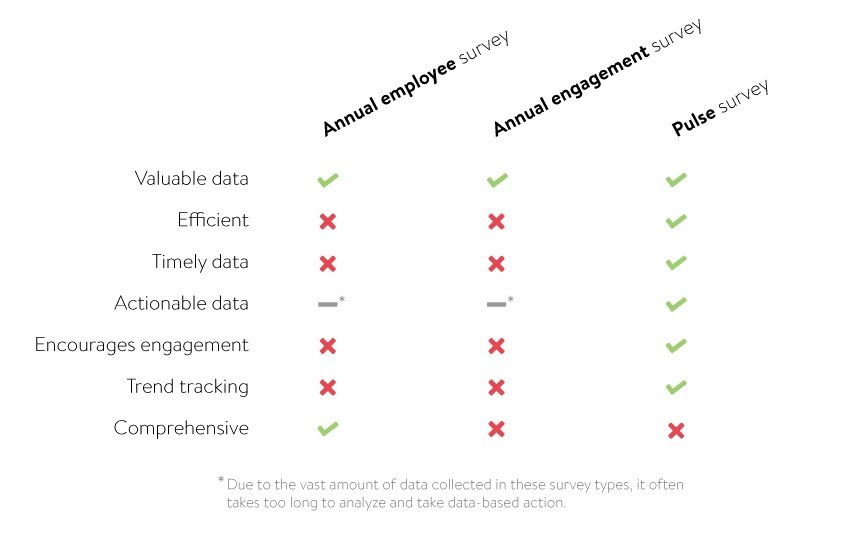How to Find the Right Format for Your Employee Surveys: Pulse Surveys vs. Annual Employee Surveys

Pulse surveys, engagement surveys, employee surveys, oh my!
It’s no secret that we’re big fans of employee pulse surveys.
We’ve given you the run-down on why they’re awesome, how to use them, the kinds of questions you should be asking, and how to use them to measure employee advocacy.
Download our Quickstart Guide to Pulse Surveys here.
Old vs. New Approaches
Since employee satisfaction is one of the most crucial factors when measuring the success of a company, employee surveys play an important role in businesses around the world. While many companies fear tough feedback from their staff, regular trend pulse surveys are improving the work climate within a company in no time.
But pulse surveys aren’t the only employee survey in the game. You’re probably wondering how they’re different from the annual employee survey and which of the survey types you should be using.
Don’t worry — we’re going to show you how pulse surveys and annual employee surveys compare, their strengths, their weaknesses, and how they can work together to gather a ton of juicy data and foster higher employee engagement.
Annual Employee Surveys Overview
What is an annual employee survey?
An annual employee survey is used by leadership to gain feedback and measure employee engagement, morale, and performance.
Traditionally, these surveys are pretty long, and despite how many internal comms and human resources professionals tear them apart, annual employee surveys are the most widely used employee surveys.
One of the most popular annual employee surveys is the annual engagement survey.
A general baseline engagement survey is at least 50 questions. These surveys are usually not too difficult to answer for employees because the questions are mostly about how they feel, and the responses are usually collected through various scales.
How do annual employee surveys work?
Annual employee surveys aim to provide a comprehensive report on a number of different organizational topics.
Primarily, they aim to measure:
Employees’ feelings on working conditions, management, and motivation.
Job satisfaction, perceptions of compensation and benefits, perceptions of company policies, diversity, and causes of turnover or retention.
Annual employee engagement surveys measure employees’ emotional commitment to an organization. They are often used to promote organizational change and support employee performance.
They do this by finding out:
If employees have the resources they need to do their jobs well.
Whether they feel supported in their roles.
How well they fit with their particular roles.
How they feel about their workloads.
Whether they find meaning and purpose in their work.
If they feel recognized or feel like they are making an impact.
If they feel empowered in their positions.
If they feel they have opportunities to grow.
How well they cooperate with others in their department, with their managers, and with other employees in the organization as a whole.
Why are annual employee surveys great?
In theory, annual surveys are fantastic because they:
Collect a lot of data from the entire population of an organization.
Provide lots of feedback on many initiatives at once.
Gather a wealth of data for deeper and wider analysis.
Can reveal previously unknown data.
Are great for creating baselines and goals while finding ways to make improvements.
When they’re designed well, employee surveys are great because they have statistical validity, can gather critical data about a company’s employees, and can be used to back large-scale changes and improvements within the company.
And why aren’t they always so awesome?
Annual employment surveys are easy to do poorly. For starters, most people don’t remember what they had for lunch yesterday, so accurately capturing and summing up their sentiments for the entire year in just one survey is just not going to happen.
Besides that obvious flaw, annual surveys tend to fall short in a number of ways:
They only use one data point to measure sentiment and stats for the entire year.
Because they aim to gather data on a large number of topics, they tend to be quite long, which discourages respondents from filling out the survey—or at least filling it out honestly.
They fail to keep up with how quickly organizations change, and therefore can fail to collect relevant or accurate data.
They are not done often enough to track flux, trends, or proper correlations.
They don’t present a clear picture of pressing issues, are likely to miss issues that pop up seasonally, and make it easy for topical or current issues to slip by.
Because they can be so long, it often takes time to analyze the data and draw significant insights.
And the longer it takes to analyze the data and get insights, the longer it will take to take action on the responses received from employees.
If there isn’t a plan in place to take action on the results, you risk making employees feel like they are not being heard or risk sending the message that you just don’t care about making their lives better. (Good luck getting them engaged in the future!)
And of course, if you are bad at incorporating feedback or making change, employees won’t see the point of the surveys and you may see a low response rate, inaccurate data, and worse engagement outcomes.

Employee Pulse Surveys Overview
What is an employee pulse survey?
Pulse surveys are super short, super specific, super fun-to-do surveys focused on a single specific area for improvement.
They can be anywhere from one to ten questions, so long as the survey takes less than four minutes to complete in its entirety.
We’re biased towards the ever-powerful one-question pulse survey because it’s quick and effective.
Employee Net Promoter Score (or ENPS) Surveys are a good example of a one-question pulse engagement survey.
That’s right—a pulse survey can also be an engagement survey! Oh, the possibilities!
How do pulse surveys work?
Pulse surveys use one to ten questions to pull relevant and timely data on employee sentiment, understanding, and engagement.
They allow data collectors to get topical insight into how employees are feeling about organizational changes, company news, and the effectiveness of training.
If done with regularity, pulse surveys allow you to track engagement and sentiment throughout the year.
Why are pulse surveys great?
Employee surveys in short, regular intervals can easily be adjusted depending on the needs of the individual business. Many companies conducting these surveys observe some awesome benefits:
They provide timely info, accurate data, and generally elicit a high response rate, which in turn causes employees to give more suggestions for improvement.
They are great listening tools that will help employees feel heard, cultivate a culture of growth and communication, and remind employees that management values their input.
They can be used as tools to aid, complement, and measure large initiatives.
They provide feedback quickly so that companies can react and respond to issues by taking immediate action.
They are perfect for monitoring people metrics and can help create momentum in discussions and relevant topics for meetings.
They are able to bring more innovation and enhance change management by making use of quick responses.
They can help heighten productivity by ramping up employee engagement, which in turn leads to a greater number of satisfied customers.
They are wonderfully complementary to annual baseline surveys and provide data for trend-tracking and seasonal flux.
Why aren’t pulse surveys always so awesome?
You cannot cover all of your organization’s critical topics with just one question.
Like most surveys, pulse surveys are still susceptible to human error. If the questions are too leading, poorly written, or trying to jam too much into one question (making it too complex to answer well), you won’t be gathering good data.
For pulse surveys to do what they are supposed to do, they absolutely have to be paired with action. Asking questions that you have no intention of actually addressing once you gather feedback will undermine any engagement you were trying to cultivate with these surveys.
If the questions are random, irrelevant, or not goal-focused, they will fail to provide valuable insight and just annoy people rather than engage them.
And finally, if you haven’t explained to employees how these surveys work or how they will be used, people will be confused about their relevance and may not answer.
Example: The Case of Amazon
While both survey types have their individual benefits, companies committed to proactively ensuring greater employee satisfaction are increasingly relying on pulse surveys. Amazon had to face harsh criticism in recent years because of its supposedly horrendous working conditions.
This has not only caused damage to the company’s image, but also to the self-image of the corporation now trying to turn things around. The board members want to learn more about the working conditions and the satisfaction of the staff at the lowest levels of the company.
Workers in the logistics centers receive daily surveys about their job satisfaction, the training they receive and opportunities for advancement as well as their direct supervisor. As a result, the so-called Amazon Connections Innovative takes things one step further than traditional employee surveys: Daily monitoring takes place.
Upper level management has to respond to the Amazon Connections surveys. In case of any questions posed by staff, the Connections team calls on the individual employee directly so as to get in-depth feedback. By keeping any employee responses outside of the Connections team 100% anonymous, the company encourages its employees to be honest.
What kind of employee survey should I be using?

Good question.
We’re not going to tell you that you should chuck out annual surveys and only use pulse surveys in your organization. Annual employee surveys have their time and place.
Instead, we recommend a combination of annual surveys and pulse surveys, with an emphasis on frequent pulse surveys because:
Basing policy, focus, or communication on one survey per year is just a bad idea. (You wouldn’t ask your spouse once per year if things were going okay, or check your finances once per year, would you?)
Without mechanisms for regular feedback, your employees will not feel heard — which can negatively impact your organization’s culture.
The formality and length of the annual survey doesn’t lead to immediate results.
Whatever survey style (or a combination thereof) you choose to use in your organization, your success or failure will ride on your survey design, including: the quality of the questions you ask, the caliber of your data, how quickly you’re able to interpret the data, and how well you’re able to follow up with employees.
If you can manage to balance all of these survey elements — and pair them with data-driven action — you’ve got a recipe for employee satisfaction, better employee outcomes, and greater organizational success.











